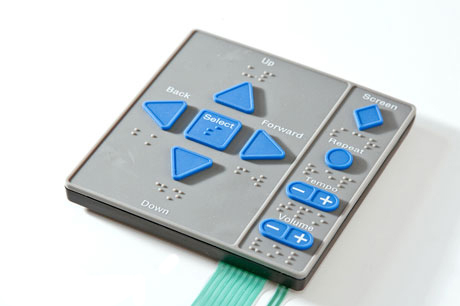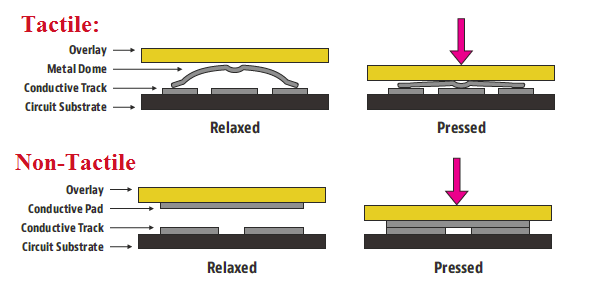Membrane Switches: The Best Choice for Compact and Reliable Controls
Membrane Switches: The Best Choice for Compact and Reliable Controls
Blog Article
Understanding the Relevance of Membrane Switches in Interface
Membrane buttons are important elements in the layout of effective user interfaces, helping with not only performance but also enhancing aesthetic allure and customer interaction. As we explore the various advantages and future trends connected with Membrane technology, it ends up being clear that these switches are more than just elements; they stand for a merging of innovation and practicality.
What Are Membrane Switches?

The spacer layer, which includes glue homes, enables for the separation of the circuit layer from the overlay, guaranteeing that the switch remains in a non-activated state up until pushed. When stress is put on the overlay, it compresses the spacer layer, bridging the space and finishing the circuit in the underlying layer. This style not only decreases the physical room needed for typical mechanical buttons however likewise improves the resilience of the gadget, as Membrane buttons are usually resistant to dirt, wetness, and other ecological elements.
Frequently located in applications ranging from customer electronic devices to medical gadgets, Membrane switches are integral to modern-day technology, giving a efficient and user-friendly user interface that straightens with modern layout requirements.
Advantages of Membrane Buttons
While countless button innovations exist, Membrane Switches deal unique advantages that make them specifically desirable in numerous applications. One of the main advantages of Membrane switches is their compact style, which enables space-saving executions in tools where realty is restricted. Their slim account not just boosts visual allure yet also promotes light-weight construction.
An additional significant benefit is their resistance to ecological variables. Membrane buttons are commonly sealed against wetness, dirt, and pollutants, making them perfect for use in requiring environments, such as medical devices and commercial devices. This durability expands the lifespan of the switch, lowering upkeep costs and boosting integrity.
Moreover, Membrane buttons can be customized to meet certain design requirements, including distinct graphics and colors that boost individual interaction. Their tactile responses choices can also be tailored to provide an enjoyable customer experience. In addition, Membrane switches are affordable, particularly in high-volume applications, as they can be generated successfully.
Applications in Different Industries

In the customer electronic devices market, Membrane switches prevail in gadgets such as microwaves, my site washing devices, and push-button controls. Their responsive comments and aesthetic choices boost individual experience while offering a streamlined, modern look. Additionally, vehicle suppliers make use of Membrane switches in dashboard controls and infomercial systems, where area is restricted, and customer involvement is crucial.
Moreover, the commercial sector leverages Membrane buttons in control panels for equipment and tools, enabling instinctive operation in typically severe environments. Their resistance to chemicals and dampness makes sure durability and integrity in these applications. Generally, the flexibility of Membrane Switches contributes substantially to their extensive use, making them indispensable in different technical domain names.
Layout Considerations for Membrane Buttons

When designing Membrane buttons, several essential factors to consider should be thought about to make sure ideal capability and customer experience. The selection of products is critical; picking long lasting, high-grade substrates can boost the button's long life and resistance to environmental variables such as moisture and temperature level fluctuations.
Secondly, the layout of the graphic overlay ought i thought about this to focus on clearness and convenience of use. Symbols and message should be readable, and the format must help with instinctive interaction (membrane switches). In addition, responsive comments is necessary; incorporating a responsive dome or other devices can enhance the customer experience by giving physical confirmation of activation
One more crucial element is the switch's electric performance. Designers should ensure that the conductive traces are effectively designed to minimize resistance and stay clear of signal disturbance. This includes analyzing the required actuation pressure and making sure compatibility with the electronic components they will certainly interface with.

Future Fads in Membrane Innovation
As technology remains to advance, Membrane buttons are poised to evolve considerably, driven by technologies in materials and manufacturing techniques. One arising trend is the incorporation of innovative materials, such as conductive inks and adaptable substratums, which enhance toughness and decrease the general weight of Membrane switches. These products not only boost the responsive feedback yet likewise enable the layout of buttons that can endure harsher environmental problems.
In addition, the combination of touch-sensitive modern technologies is changing traditional Membrane Switches right into more interactive user interfaces. Capacitive touch sensors embedded within Membrane switch panels can offer a more responsive and intuitive individual experience, straightening with the expanding need for streamlined, modern-day styles in customer electronic devices.
Additionally, advancements in printing methods, such as digital and 3D printing, enable fast prototyping and personalization of Membrane switches. This versatility allows suppliers to react much more rapidly to market demands and consumer choices.
Last but not least, sustainability is becoming a significant focus, with producers checking out environment-friendly materials and procedures. As these patterns unfold, the future of Membrane technology promises boosted functionality, aesthetic allure, and environmental responsibility, solidifying their duty in sophisticated interface throughout different industries.
Verdict
To conclude, Membrane Switches represent an essential click for more info component in the design of interface, incorporating performance with visual adaptability. Their advantages, including toughness and resistance to ecological factors, make them ideal for diverse applications throughout various markets. In addition, thoughtful layout factors to consider improve customer communication and experience. As improvements in technology continue, the advancement of Membrane switches is anticipated to further improve interface, driving innovation and enhancing functionality in an increasingly complex technical landscape.
Membrane buttons are integral elements in the layout of efficient user interfaces, helping with not only functionality but likewise boosting aesthetic charm and customer interaction.Membrane Switches serve as an essential element in various user interfaces, helping with a seamless communication in between individuals and electronic gadgets.While many switch technologies exist, Membrane Switches deal distinct benefits that make them particularly preferable in various applications.Moreover, Membrane buttons can be customized to fulfill details design needs, incorporating unique graphics and shades that boost user interaction.In final thought, Membrane Switches stand for a crucial component in the design of individual interfaces, combining performance with visual flexibility.
Report this page